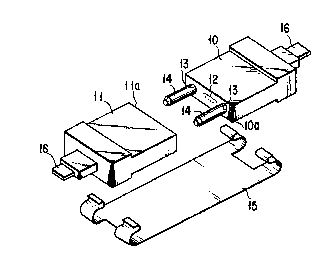Some of the information on this Web page has been provided by external sources. The Government of Canada is not responsible for the accuracy, reliability or currency of the information supplied by external sources. Users wishing to rely upon this information should consult directly with the source of the information. Content provided by external sources is not subject to official languages, privacy and accessibility requirements.
Any discrepancies in the text and image of the Claims and Abstract are due to differing posting times. Text of the Claims and Abstract are posted:
| (12) Patent: | (11) CA 2077355 |
|---|---|
| (54) English Title: | MULTICORE OPTICAL CONNECTOR |
| (54) French Title: | CONNECTEUR DE FIBRES OPTIQUES GROUPEES |
| Status: | Expired and beyond the Period of Reversal |
| (51) International Patent Classification (IPC): |
|
|---|---|
| (72) Inventors : |
|
| (73) Owners : |
|
| (71) Applicants : |
|
| (74) Agent: | SMART & BIGGAR LP |
| (74) Associate agent: | |
| (45) Issued: | 1999-08-24 |
| (22) Filed Date: | 1992-09-02 |
| (41) Open to Public Inspection: | 1993-03-05 |
| Examination requested: | 1992-09-02 |
| Availability of licence: | N/A |
| Dedicated to the Public: | N/A |
| (25) Language of filing: | English |
| Patent Cooperation Treaty (PCT): | No |
|---|
| (30) Application Priority Data: | ||||||
|---|---|---|---|---|---|---|
|
A multicore optical connector includes a connector
body having a pair of alignment pin holes and a plurality
of optical fiber holes formed therebetween and
optical fibers inserted in the optical fiber holes such
that the end faces of the optical fibers are exposed
through the optical fiber holes. In the multicore
optical connector, the optical fiber holes are divided
into optical fiber hole groups of a number which
coincides with the number of the groups of the optical
fibers, and the optical fiber hole groups are separated
from one another.
Note: Claims are shown in the official language in which they were submitted.
Note: Descriptions are shown in the official language in which they were submitted.

2024-08-01:As part of the Next Generation Patents (NGP) transition, the Canadian Patents Database (CPD) now contains a more detailed Event History, which replicates the Event Log of our new back-office solution.
Please note that "Inactive:" events refers to events no longer in use in our new back-office solution.
For a clearer understanding of the status of the application/patent presented on this page, the site Disclaimer , as well as the definitions for Patent , Event History , Maintenance Fee and Payment History should be consulted.
| Description | Date |
|---|---|
| Inactive: IPC from MCD | 2006-03-11 |
| Inactive: IPC from MCD | 2006-03-11 |
| Time Limit for Reversal Expired | 2005-09-02 |
| Letter Sent | 2004-09-02 |
| Grant by Issuance | 1999-08-24 |
| Inactive: Cover page published | 1999-08-23 |
| Inactive: Final fee received | 1999-05-11 |
| Inactive: Correspondence - Formalities | 1999-05-11 |
| Pre-grant | 1999-05-11 |
| Notice of Allowance is Issued | 1998-11-18 |
| Letter Sent | 1998-11-18 |
| Notice of Allowance is Issued | 1998-11-18 |
| Inactive: Status info is complete as of Log entry date | 1998-11-03 |
| Inactive: Application prosecuted on TS as of Log entry date | 1998-11-03 |
| Inactive: Approved for allowance (AFA) | 1998-10-14 |
| Application Published (Open to Public Inspection) | 1993-03-05 |
| Request for Examination Requirements Determined Compliant | 1992-09-02 |
| All Requirements for Examination Determined Compliant | 1992-09-02 |
There is no abandonment history.
The last payment was received on 1998-08-11
Note : If the full payment has not been received on or before the date indicated, a further fee may be required which may be one of the following
Please refer to the CIPO Patent Fees web page to see all current fee amounts.
| Fee Type | Anniversary Year | Due Date | Paid Date |
|---|---|---|---|
| MF (application, 5th anniv.) - standard | 05 | 1997-09-02 | 1997-08-06 |
| MF (application, 6th anniv.) - standard | 06 | 1998-09-02 | 1998-08-11 |
| Final fee - standard | 1999-05-11 | ||
| MF (patent, 7th anniv.) - standard | 1999-09-02 | 1999-08-09 | |
| MF (patent, 8th anniv.) - standard | 2000-09-04 | 2000-08-16 | |
| MF (patent, 9th anniv.) - standard | 2001-09-03 | 2001-08-17 | |
| MF (patent, 10th anniv.) - standard | 2002-09-03 | 2002-08-16 | |
| MF (patent, 11th anniv.) - standard | 2003-09-02 | 2003-08-21 |
Note: Records showing the ownership history in alphabetical order.
| Current Owners on Record |
|---|
| NIPPON TELEGRAPH & TELEPHONE CORPORATION |
| THE FURUKAWA ELECTRIC CO., LTD. |
| Past Owners on Record |
|---|
| HIROYUKI YAMADA |
| JUN YAMAKAWA |
| MASAMI SAITO |
| MICHITO MATSUMOTO |
| TADASHI HAIBARA |
| TOSHIHIKO OOTA |